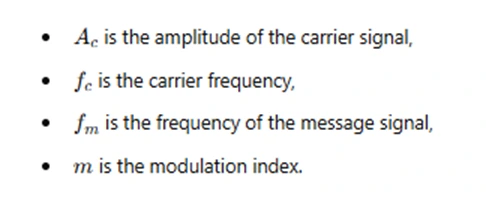How to Solve AM and FM Modulation Problems in MATLAB

Signal processing is one of the core areas in electrical engineering, and as a student, you may often find yourself dealing with various modulation techniques such as Amplitude Modulation (AM) and Frequency Modulation (FM). These techniques are fundamental to communication systems and often form the basis for assignments and projects in courses related to communication engineering, electronics, and signal processing.
If you're looking to complete your signal processing assignment efficiently, understanding how to solve AM and FM modulation problems using MATLAB is an essential skill. MATLAB, a powerful computing environment for numerical analysis, is often used in academia for solving complex engineering problems. Its easy-to-use interface and built-in functions make it an ideal tool for simulating and analyzing AM and FM signals. In this blog, we will guide you through the process of solving AM and FM modulation problems in MATLAB, providing step-by-step instructions, examples, and tips to help you complete your signal processing assignment effectively. Additionally, if you ever feel overwhelmed, MATLAB assignment help can provide you with expert guidance on more complex topics.

Understanding AM and FM Modulation
Before jumping into MATLAB simulations, it's crucial to grasp the theoretical aspects of AM and FM modulation. Both AM and FM are types of analog modulation used to encode information onto a carrier signal.
Amplitude Modulation (AM)
In Amplitude Modulation, the amplitude of the carrier wave is varied in proportion to the message signal. The mathematical expression for an AM signal is given by:

Where:

The term  is the message signal that modulates the carrier. When solving AM modulation problems, your task typically involves generating the carrier signal, modulating it with the message signal, and plotting the resulting modulated signal.
is the message signal that modulates the carrier. When solving AM modulation problems, your task typically involves generating the carrier signal, modulating it with the message signal, and plotting the resulting modulated signal.
Frequency Modulation (FM)
Frequency Modulation, on the other hand, involves varying the frequency of the carrier wave according to the message signal. The mathematical expression for an FM signal is:

Where:

FM modulation is more resistant to noise compared to AM, and its applications are seen in radio broadcasting and telecommunications.
Step-by-Step Guide to Solving AM and FM Modulation Problems in MATLAB
Step 1: Define the Message Signal
Start by defining the message signal (modulating signal). Typically, the message signal is a low-frequency sinusoidal wave:
% Parameters for message signal
Am = 1; % Amplitude of message signal
fm = 10; % Frequency of message signal (Hz)
t = 0:0.001:1; % Time vector
% Message signal
m_t = Am * sin(2 * pi * fm * t);
plot(t, m_t);
title('Message Signal');
xlabel('Time (s)');
ylabel('Amplitude');
grid on;
This code creates and plots a sine wave representing the message signal.
Step 2: Define the Carrier Signal
Next, define the high-frequency carrier signal:
% Parameters for carrier signal
Ac = 2; % Amplitude of carrier signal
fc = 100; % Frequency of carrier signal (Hz)
% Carrier signal
c_t = Ac * cos(2 * pi * fc * t);
plot(t, c_t);
title('Carrier Signal');
xlabel('Time (s)');
ylabel('Amplitude');
grid on;
The carrier signal will act as the basis for modulation.
Step 3: Perform AM Modulation
Implementing AM modulation in MATLAB is straightforward using the formula:
% AM Modulated signal
modulated_AM = (1 + m_t) .* c_t;
% Plot AM signal
plot(t, modulated_AM);
title('AM Modulated Signal');
xlabel('Time (s)');
ylabel('Amplitude');
grid on;
This code generates the AM-modulated signal by superimposing the message signal on the carrier signal's amplitude.
Step 4: Perform FM Modulation
FM modulation requires integrating the message signal. MATLAB simplifies this process:
% Frequency deviation
kf = 50; % Frequency sensitivity factor
% FM Modulated signal
modulated_FM = cos(2 * pi * fc * t + kf * cumsum(m_t) * (t(2) - t(1)));
% Plot FM signal
plot(t, modulated_FM);
title('FM Modulated Signal');
xlabel('Time (s)');
ylabel('Amplitude');
grid on;
Here, the cumsum function approximates the integral of the message signal.
Step 5: Analyze the Modulated Signals
Visualization is key to understanding modulation. MATLAB’s subplot function can display multiple plots for comparison:
subplot(3, 1, 1);
plot(t, m_t);
title('Message Signal');
xlabel('Time (s)');
ylabel('Amplitude');
grid on;
subplot(3, 1, 2);
plot(t, modulated_AM);
title('AM Modulated Signal');
xlabel('Time (s)');
ylabel('Amplitude');
grid on;
subplot(3, 1, 3);
plot(t, modulated_FM);
title('FM Modulated Signal');
xlabel('Time (s)');
ylabel('Amplitude');
grid on;
Additional Tips for Efficient MATLAB Implementation
Validate Parameters
Always validate the parameters for carrier and message signals. Incorrect parameters can distort the modulated signals, making them unsuitable for analysis or transmission.
Experiment with Modulation Indices
The modulation index significantly impacts the quality of the modulated signal. Experiment with different values to observe their effects on the output.
Leverage Built-In MATLAB Functions
MATLAB provides built-in functions such as ammod and fmmod for AM and FM modulation. Using these can save time while ensuring accurate results:
% AM Modulation using built-in function
modulated_AM_builtin = ammod(m_t, fc, 1/t(2));
% FM Modulation using built-in function
modulated_FM_builtin = fmmod(m_t, fc, 1/t(2), kf);
Use Spectral Analysis
Perform spectral analysis to examine the frequency components of the modulated signals using MATLAB’s fft function:
% Spectrum of AM Signal
AM_spectrum = fft(modulated_AM);
f = linspace(-1/(2*t(2)), 1/(2*t(2)), length(AM_spectrum));
plot(f, abs(fftshift(AM_spectrum)));
title('Spectrum of AM Signal');
xlabel('Frequency (Hz)');
ylabel('Amplitude');
grid on;
This approach provides insights into how the signal energy is distributed across frequencies.
Troubleshooting Common Issues
Distorted Modulation
If the AM or FM signal looks distorted:
- Check if the message signal exceeds the carrier signal’s amplitude.
- Verify the sampling rate. It should be high enough to satisfy the Nyquist criterion.
Misaligned Plots
Ensure consistent time vectors for all signals. A mismatch in dimensions can result in errors during plotting or computation.
Difficulty in Decoding
If the modulated signal cannot be demodulated correctly, revisit the modulation indices and parameters.
Applications in Assignments and Real-World Scenarios
Understanding AM and FM modulation has practical implications. From broadcasting to IoT applications, these techniques form the backbone of communication systems. By mastering them in MATLAB, you not only complete your assignments but also gain valuable skills for real-world challenges.
Conclusion
AM and FM modulation problems in MATLAB are fundamental yet rewarding tasks for signal processing students. By following this structured guide, you can confidently complete your MATLAB assignments, ensuring clarity and accuracy in your work. If you’re still struggling, don’t hesitate to seek MATLAB assignment help to overcome specific challenges. Remember, consistent practice is key to mastering these techniques and excelling in your field.